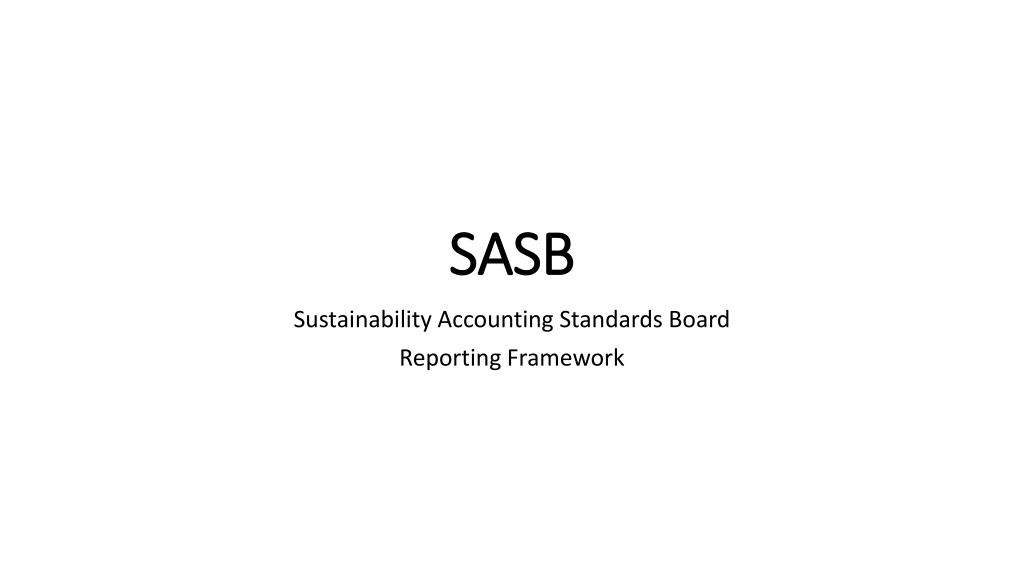SASB Sustainability Reporting Framework Overview
Financially material SASB standards aim to assist businesses in identifying, managing, and reporting on sustainability topics crucial to investors. These industry-specific standards focus on issues likely to impact a company's financial condition or performance. The Sustainability Framework by SASB organizes topics under five key dimensions, including environmental impacts. Ultimately, companies decide what is financially material and which information should be disclosed, considering legal requirements.
Download Presentation

Please find below an Image/Link to download the presentation.
The content on the website is provided AS IS for your information and personal use only. It may not be sold, licensed, or shared on other websites without obtaining consent from the author. Download presentation by click this link. If you encounter any issues during the download, it is possible that the publisher has removed the file from their server.
E N D
Presentation Transcript
SASB SASB Sustainability Accounting Standards Board Reporting Framework
OVERVIEW OVERVIEW Financially Material: SASB s mission is to help businesses around the world identify, manage and report on the sustainability topics that matter most to their investors. Market Informed: SASB standards are developed based on extensive feedback from companies, investors, and other market participants as part of a transparent, publicly-documented process. Industry Specific: SASB standards differ by industry, enabling investors and companies to compare performance from company to company within an industry.
FINANCIAL MATERIALITY SASB standards focus on financially material issues to help businesses report on sustainability topics that matter most to investors Although a lot of ESG information is disclosed publicly, often it can be difficult to identify and assess which information is most useful for making financially-related decisions SASB identifies financially material issues, which are the issues that are reasonably likely to impact the financial condition or operating performance of a company and therefore are most important to investors Ultimately, companies decide what is financially material and what information should be disclosed, taking legal requirements into account
SUSTAINABILITY FRAMEWORK SUSTAINABILITY FRAMEWORK Sustainability accounting reflects the management of a corporation s environmental and social impacts arising from production of goods and services, as well as its management of the environmental and social capitals necessary to create long-term value It also includes the impacts that sustainability challenges have on innovation, business models, and corporate governance Therefore, SASB s sustainability topics are organized under five broad sustainability dimensions In developing its standards, SASB identified sustainability topics from a set of 26 broadly relevant sustainability issues organized under these five sustainability dimensions
ENVIRONMENT ENVIRONMENT This dimension includes environmental impacts, either through the use of nonrenewable, natural resources as inputs to the factors of production or through harmful releases into the environment that may result in impacts to the company s financial condition or operating performance.
SOCIAL CAPITAL SOCIAL CAPITAL This dimension relates to the expectation that a business will contribute to society in return for a social license to operate It addresses the management of relationships with key outside parties, such as customers, local communities, the public, and the government It includes issues related to human rights, protection of vulnerable groups, local economic development, access to and quality of products and services, affordability, responsible business practices in marketing, and customer privacy
HUMAN CAPITAL HUMAN CAPITAL This dimension addresses the management of a company s human resources (employees and individual contractors) as key assets to delivering long-term value It includes issues that affect the productivity of employees, management of labor relations, and management of the health and safety of employees and the ability to create a safety culture
BUSINESS MODEL BUSINESS MODEL This dimension addresses the integration of environmental, human, and social issues in a company s value-creation process, including resource recovery and other innovations in the production process; as well as in product innovation, including efficiency and responsibility in the design, use phase, and disposal of products
LEADERSHIP & GOVERNANCE LEADERSHIP & GOVERNANCE This dimension involves the management of issues that are inherent to the business model or common practice in the industry and that are in potential conflict with the interest of broader stakeholder groups, and therefore create a potential liability or a limitation or removal of a license to operate This includes regulatory compliance, risk management, safety management, supply-chain and materials sourcing, conflicts of interest, anticompetitive behavior, and corruption and bribery
MATERIALITY MAP MATERIALITY MAP https://materiality.sasb.org Although the universe of sustainability issues served as a starting point for the SASB s standard setting, this extensive list was refined through a series of steps designed to identify those issues reasonably likely to have material impacts on companies in an industry. Because each of these issues tends to have a different impact or consequence depending on the context in which it arises, sustainable corporate activities will vary from one industry to another, meaning each industry has its own unique sustainability profile. The disclosure topics included in SASB s industry-specific standards are therefore a sub-set of this universe of sustainability issues, tailored to the industry s specific context.

























